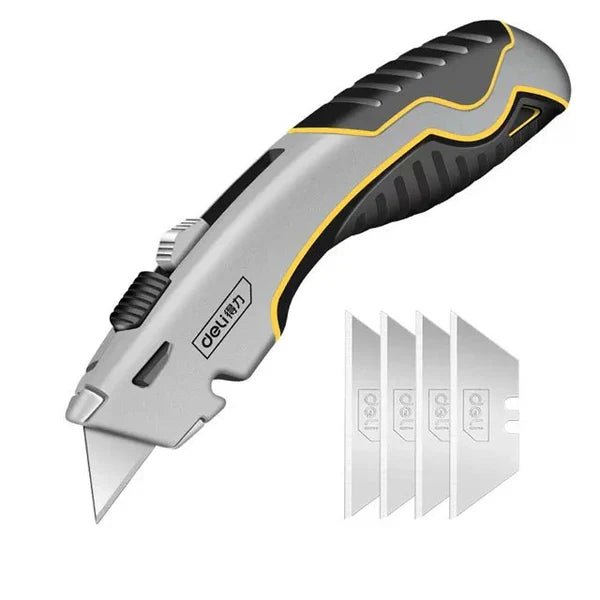
The Complete Guide to Alloy Utility Knives: From Workplace to Workshop
Share
Introduction
The Alloy Utility Knife, also known as a box cutter, is one of the most universal cutting tools used today. From warehouses and construction sites to art studios and kitchens, it’s a staple for professionals and hobbyists alike. But not all utility knives are created equal — and choosing the right one can greatly affect your efficiency, safety, and results.
In this guide, we’ll cover everything you need to know: the history of utility knives, why alloy construction is superior, the best uses, and how to care for your knife so it lasts a lifetime.
A Brief History of Utility Knives
Utility knives have been around for centuries in one form or another. Early versions were simply fixed-blade knives used for general cutting. Modern retractable designs gained popularity in the 20th century for their safety and replaceable blades. Today’s alloy-handled models combine ergonomic comfort with industrial-grade durability.
Why Alloy is the Best Choice
When you’re cutting heavy materials day in and day out, the handle matters as much as the blade. Alloy handles:
- Resist wear and tear better than plastic.
- Provide a firm, slip-resistant grip.
- Maintain structural integrity under high pressure.
- Offer a more balanced weight for precision cutting.
Key Features to Look For
- Retractable Blade: Enhances safety when not in use.
- Quick Blade Change: No tools required in many models.
- Blade Storage Compartment: Some designs let you store extras inside the handle.
- Textured Grip: Reduces slipping and hand fatigue.
- Locking Mechanism: Prevents the blade from retracting accidentally during heavy cuts.
Top Uses in Different Settings
In the Warehouse
- Cutting strapping, shrink wrap, and heavy-duty packaging.
- Breaking down large quantities of boxes efficiently.
In Construction
- Cutting drywall, roofing felt, insulation, and flooring materials.
In the Workshop
- Shaping wood veneers, leather, or plastic sheets.
- Trimming foam boards and upholstery.
At Home
- DIY repairs, craft projects, and seasonal decor setups.
- Garden prep — opening seed bags or trimming plant ties.
Safety Tips for Professionals
- Replace blades often to prevent accidents caused by excessive force.
- Use cut-resistant gloves when handling dense materials.
- Always cut on a stable surface.
- Train employees in safe knife handling — especially in warehouse environments.
Maintaining Your Alloy Utility Knife
- Wipe down after use to remove dust, glue, or debris.
- Store in a dry place to prevent blade rusting.
- Check the blade housing for damage regularly.
- Lubricate the blade slide if it becomes stiff.
Why It’s a Must-Have Tool
Few tools match the versatility of a utility knife. Its compact size, ease of maintenance, and adaptability make it indispensable across industries. For anyone handling materials regularly, investing in a quality alloy-handled utility knife is an easy decision.
Conclusion
Whether you’re opening packages in a retail store, cutting drywall on a construction site, or tackling a home project, the right utility knife makes the job smoother, safer, and more efficient. The alloy utility knife is built for the long haul — a trusted companion that won’t let you down.
FAQs
1. What’s the advantage of an alloy handle over plastic?
Alloy handles are stronger, longer-lasting, and more resistant to bending or cracking.
2. Can I use the same knife for different materials?
Yes — just change the blade type to suit your material.
3. Is it safe for beginners?
Yes, if they follow safety guidelines like retracting the blade after use and cutting away from the body.
4. Do I need special blades for an alloy knife?
No, most use standard utility knife blades available in hardware stores.
5. How long will an alloy utility knife last?
With proper care, the handle can last many years — blades are the only part you regularly replace.
